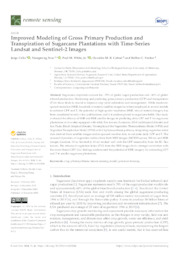Improved modeling of gross primary production and transpiration of sugarcane plantations with time-series Landsat and Sentinel-2 images.
Improved modeling of gross primary production and transpiration of sugarcane plantations with time-series Landsat and Sentinel-2 images.
Autoria: CELIS, J.; XIAO, X.; WHITE, P. M.; CABRAL, O. M. R.; FREITAS, H. C.
Resumo: Abstract: Sugarcane croplands account for ~70% of global sugar production and ~60% of global ethanol production. Monitoring and predicting gross primary production (GPP) and transpiration (T) in these fields is crucial to improve crop yield estimation and management. While moderate-spatial-resolution (MSR, hundreds of meters) satellite images have been employed in several models to estimate GPP and T, the potential of high-spatial-resolution (HSR, tens of meters) imagery has been considered in only a few publications, and it is underexplored in sugarcane fields. Our study evaluated the efficacy of MSR and HSR satellite images in predicting daily GPP and T for sugarcane plantations at two sites equipped with eddy flux towers: Louisiana, USA (subtropical climate) and Sao Paulo, Brazil (tropical climate). We employed the Vegetation Photosynthesis Model (VPM) and Vegetation Transpiration Model (VTM) with C4 photosynthesis pathway, integrating vegetation index data derived from satellite images and on-ground weather data, to calculate daily GPP and T. The seasonal dynamics of vegetation indices from both MSR images (MODIS sensor, 500 m) and HSR images (Landsat, 30 m; Sentinel-2, 10 m) tracked well with the GPP seasonality from the EC flux towers. The enhanced vegetation index (EVI) from the HSR images had a stronger correlation with the tower-based GPP. Our findings underscored the potential of HSR imagery for estimating GPP and T in smaller sugarcane plantations.
Ano de publicação: 2023
Tipo de publicação: Artigo de periódico
Unidade: Embrapa Meio Ambiente
Palavras-chave: Cana de Açúcar, Fotossíntese, Photosynthesis, Remote sensing, Satélite, Sensoriamento Remoto, Sugarcane, Transpiration, Transpiração Vegetal
Observações
1 - Por padrão são exibidas publicações dos últimos 20 anos. Para encontrar publicações mais antigas, configure o filtro ano de publicação, colocando o ano a partir do qual você deseja encontrar publicações. O filtro está na coluna da esquerda na busca acima.
2 - Para ler algumas publicações da Embrapa (apenas as que estão em formato ePub), é necessário ter, no celular ou computador, um desses softwares gratuitos. Sistemas Android: Google Play Livros; IOS: iBooks; Windows e Linux: software Calibre.
Acesse outras publicações
Acesse a Base de Dados da Pesquisa Agropecuária (BDPA) para consultar o acervo completo das bibliotecas da Embrapa.

